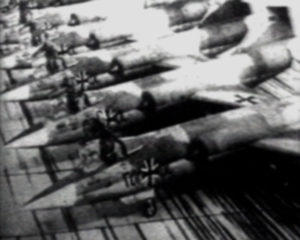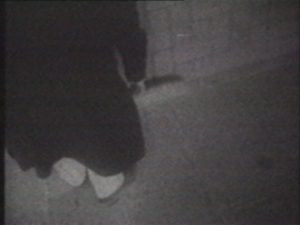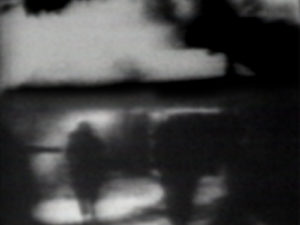Wolf Vostell
DÉ -COLL/AGE
(FROM THE)-(GLUE)/(AGE)
I first came to Paris, a seemingly intact cosmopolitan city, from Germany’s destructive post-war period, in 1954. The contrast was vast. I immediately noticed that there were no ruins, as in Germany, but that in every street, and in many of the subway stations, there were more torn posters than legible and intact ones.
Inspired by the report in Le Figaro on 6th September, 1954 with the heading: PEU APRES SON DÉCOLLAGE…UN SUPER-CONSTELLATION TOMBE ET S’ENGLOUTIT DANS LA RIVIÈRE SHANNON, I began to contemplate the phenomenon with the word décollage. That same day, I found the dictionary explanation: Décoll/age ( ) m lifting off, detaching that which is glued, start, take off n by an airplane off the ground, -er ( ) to detach, to become unglued, to become unstuck (la), separating, leaving, pej, to bite the dust…
I made a visual analogy between crashed jumbo jets and torn posters. From then on, my area of interest concerning REALITY was outlined and defined, and to this way. I follow this formal principle of the ambivalent and complex iconographic – and pertaining to content – action, in my work. All of sudden, I realized that the phenomena of the time and the environment in which I lived were not reflected in the machisme of that period.
Took on the task of adopting what I saw and experienced, felt and heard, events and processes, within my work, and of consciously making a different kind of art which was to be completely contrary to prevailing contemporary art. I was interested in destructive processes and the remains resulting from these transformations. First of all, I began to rip posters, very small pieces, wherever I was, which I glued into sketchbooks, unchanged. Since the décoll/age, the actual process, had been made by a person unknown to me; I wanted to preserve this process and conserve it as a value that was not covered by any of the other arts.
Mobile coll/age is de-coll/age
De-coll/age is mobile collage.
Mobiles collage are actions.
Actions are transformations.
What fascinated me were the symptoms and emanations of a permanent transformation in an environment in which destruction in general, and its artistic statement, along with resolution and juxtaposition, were the strongest elements. de-coll/age as a production principle using destruction and autodestruction, in stark contrast to collage in which mostly intact, arguably heterogeneous objects and materials, are juxtaposed.
Around 1958, I was introduced to a book by my teacher, AM Cassandre in Paris, called: LE THEATRE EST DANS LA RUE. As inventor of the modern billboard in the twenties, he thereby referred to the accumulation of posters and information in the big city. I understood it as a call to action. This meant becoming a part of the action myself. My fist de-coll/age-happening took place in front of an audience. Around the same time, I got to know the work of the Dadaists and, mainly Duchampian art. It occurred me to me that, in his declaration of the FOUND OBJECT* Duchamp disregarded its use, that is, processes of use and happening. To DECLARE THE FOUND, TORN POSTER A WORK OF ART WOULD HAVE CONSTITUTED NO PROGRESS SINCE MARCEL DUCHAMP, therefore I was more interested in the act OF TEARING.
*as a work of art
(…)
Thus, demonstrations of TEARING turned into HAPPENINGS with, and for, an audience. By transferring the same process to other information carriers, my dé-coll/aged TV images, and later, from 1961, my OVERPAINTINGS of photographs and magazine double spreads emerged.
(…)
Berlin, 1971












